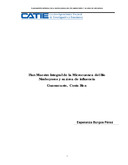| dc.description.abstract | El fin del Plan Maestro Integral de la Microcuenca del Río Nimboyores y su área de influencia es el de servir de instrumento para tomar decisiones sobre el manejo del recurso hídrico y apoyar la gestión del SENARA, en la búsqueda de soluciones al conflicto por el uso del agua, entre la actividad turística y las comunidades costeras de Guanacaste, Costa Rica. Situación que se presenta por la disminución de precipitaciones en la época seca de la región, que coincide con el periodo de mayor demanda turística. El reto en planificación fue vincular dos modelos, la planeación física resultante de la zonificación obtenida y la planeación estratégica en función de la visión de los actores sociales, para lo cual se identificaron tres escenarios: actual, tendencial y prospectivo, del cual se partió hacia el establecimiento de las áreas y criterios de intervención así como a la formulación del plan en sus políticas, estrategias y programas sectoriales entorno a la sostenibilidad del recurso hídrico. The objective of the integrated master plan for the Nimboyores river sub-watershed and its area of influence is to serve as a decision making instrument for hydric resource management and to support SENARA in looking for solutions for the water use conflict between tourism and the costal communities in Guanacaste, Costa Rica. This conflict is due to the reduction of precipitation in the dry season in the region which coincides with the period of greatest demands by tourism. One planning challenge was to combine two models which were physical planning of the zoning and strategy planning as a functional of the vision of the social actors. Three scenarios were identified: a current scenario, a scenario which showed tendencies, and a prospective scenario which began with the establishment of the areas and intervention criteria such as formulation of a plan's policies, strategies, and sector prograMON in relation to the sustainability of the hydric resource. | es_ES |


